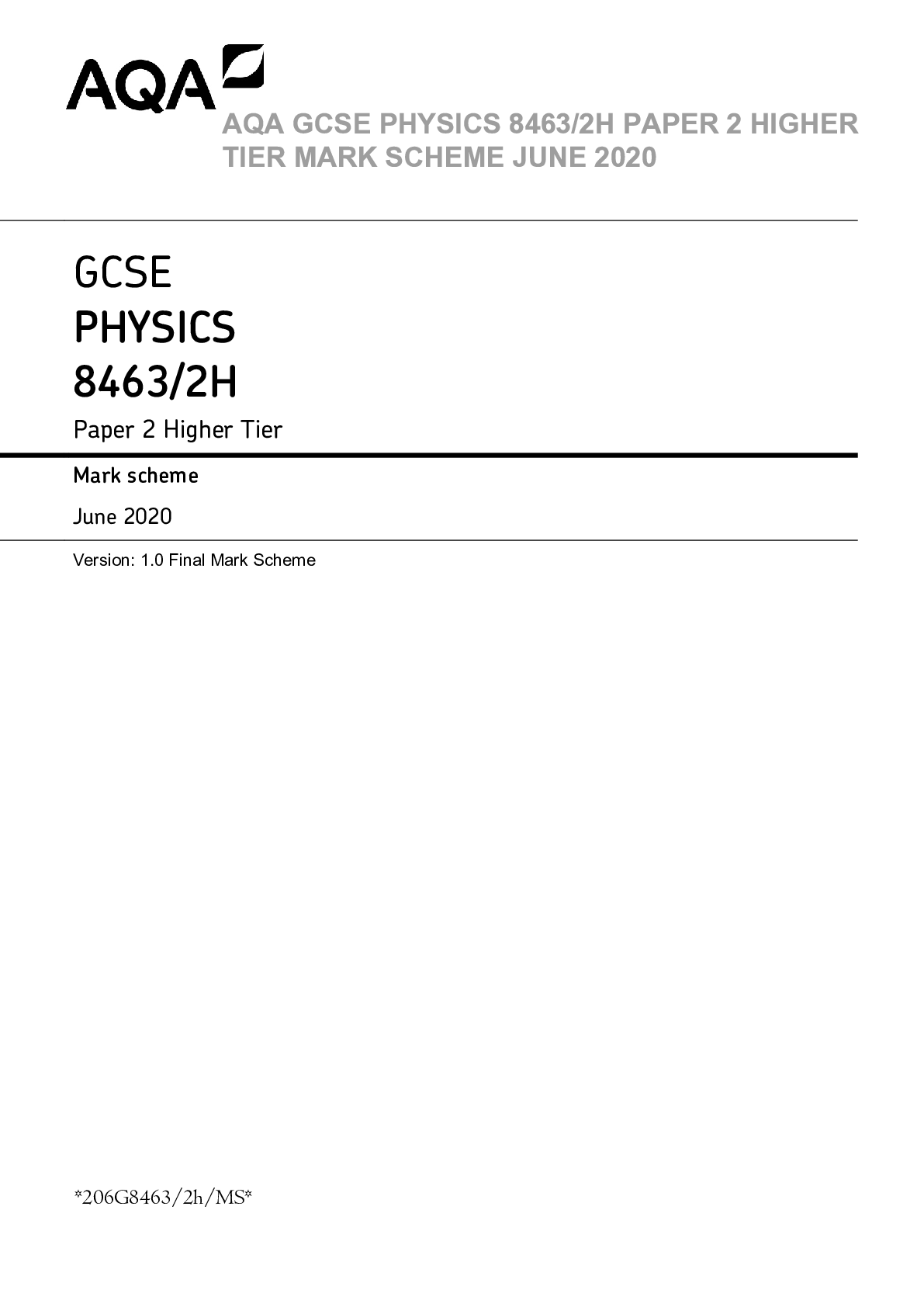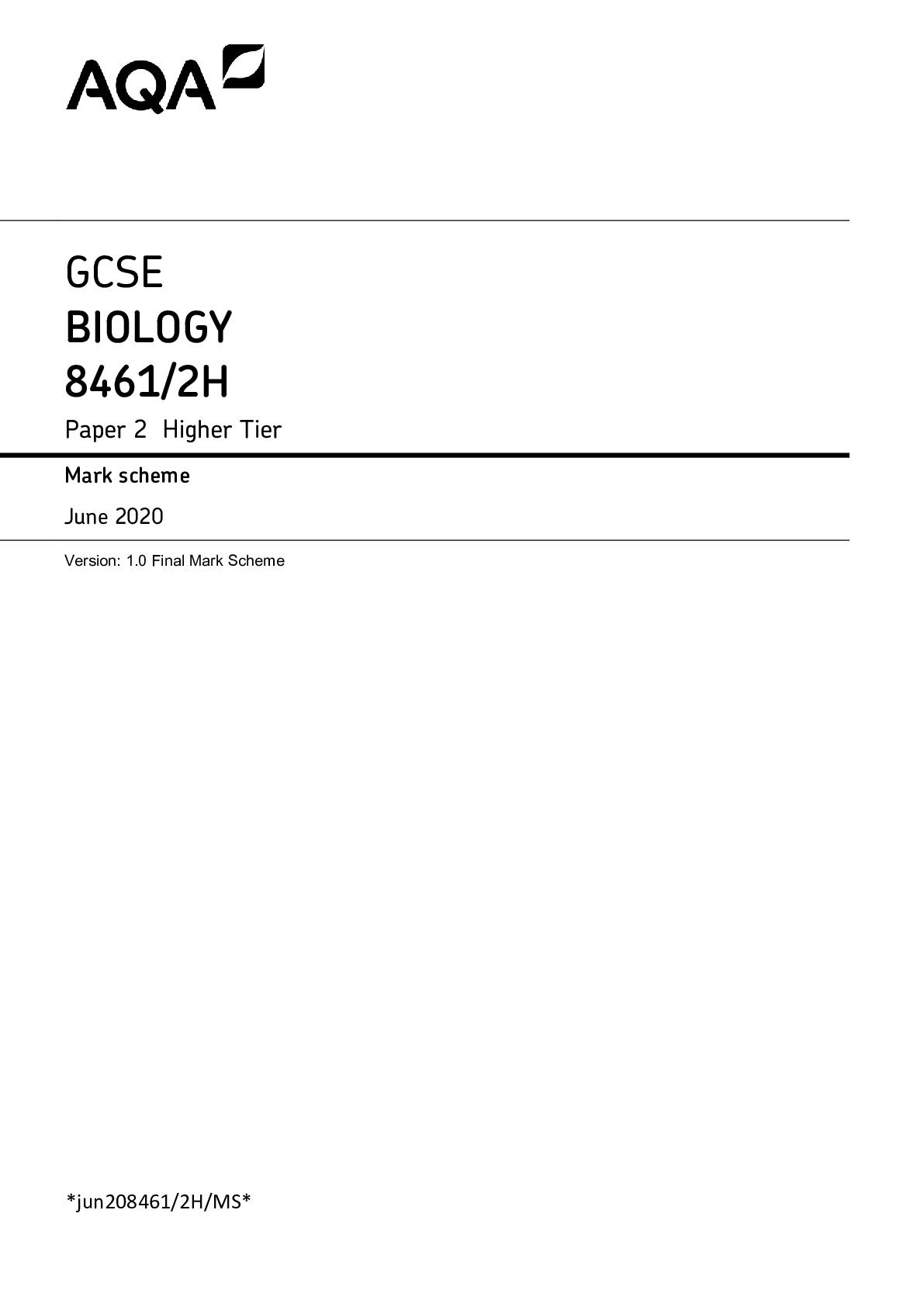English > QUESTIONS & ANSWERS > AQA GCSE ENGLISH LANGUAGE 8700/2 Paper 2 Writers’ Viewpoints and Perspectives Mark scheme November (All)
AQA GCSE ENGLISH LANGUAGE 8700/2 Paper 2 Writers’ Viewpoints and Perspectives Mark scheme November 2021 Version: 1.0 FinalGCSE ENGLISH LANGUAGE 8700/2 Paper 2 Writers’ viewpoints and perspectives Mark scheme June 2021
Document Content and Description Below
AQA GCSE ENGLISH LANGUAGE 8700/2 Paper 2 Writers’ Viewpoints and Perspectives Mark scheme November 2021 Version: 1.0 FinalGCSE ENGLISH LANGUAGE 8700/2 Paper 2 Writers’ viewpoints and perspect... ives Mark scheme June 2021 Version: 1.0 Final *Jun2187002/MS*MARK SCHEME – GCSE ENGLISH LANGUAGE – 8700/2 – JUNE 2021 2 Mark schemes are prepared by the Lead Assessment Writer and considered, together with the relevant questions, by a panel of subject teachers. This mark scheme includes any amendments made at the standardisation events which all associates participate in and is the scheme which was used by them in this examination. The standardisation process ensures that the mark scheme covers the students’ responses to questions and that every associate understands and applies it in the same correct way. As preparation for standardisation each associate analyses a number of students’ scripts. Alternative answers not already covered by the mark scheme are discussed and legislated for. If, after the standardisation process, associates encounter unusual answers which have not been raised they are required to refer these to the Lead Examiner. It must be stressed that a mark scheme is a working document, in many cases further developed and expanded on the basis of students’ reactions to a particular paper. Assumptions about future mark schemes on the basis of one year’s document should be avoided; whilst the guiding principles of assessment remain constant, details will change, depending on the content of a particular examination paper. Further copies of this mark scheme are available from aqa.org.uk Copyright information AQA retains the copyright on all its publications. However, registered schools/colleges for AQA are permitted to copy material from this booklet for their own internal use, with the following important exception: AQA cannot give permission to schools/colleges to photocopy any material that is acknowledged to a third party even for internal use within the centre. Copyright © G4004 AQA and its licensors. All rights reserved.MARK SCHEME – GCSE ENGLISH LANGUAGE – 8700/2 – JUNE 2021 3 Introduction The information provided for each question is intended to be a guide to the kind of answers anticipated and is neither exhaustive nor prescriptive. All appropriate responses should be given credit. Level of response marking instructions Level of response mark schemes for GCSE English Language are broken down into four levels (where appropriate). In the first column each level is identified with one or two key words that represent the differences in the skills then described. These key words show the progression from Level 1 to 4 and are: Level 4 Perceptive, detailed Level 3 Clear, relevant Level 2 Some, attempts Level 1 Simple, limited. This is followed in the second column by a description of the different qualities required in the student’s answer for that level. These are called the skills descriptors. In order to reach a given level, a student must fulfil one or more of the skills descriptors for that level. The third column of the mark scheme is the Indicative Standard. This is an important feature of the mark scheme for GCSE English Language. It provides exemplification of the skills descriptors at each level and offers a small number of different comments at the required standard to give an indication of the quality of response that is typical for that level. It shows the progression from Level 1 to 4. The Indicative Standard is not intended to be a model answer nor a complete response, and it does not exemplify required content. Students may reach a given level by making one or more comments of the quality demonstrated by the Indicative Standard and do not have to meet all the skill descriptors at that level. The standardising scripts will further exemplify each of the levels. You must refer to the standardising material throughout your marking. Step 1 Annotate the response When marking a response you should first read through the student’s answer and annotate each section using the comments from the statement bank to show the qualities that are being demonstrated, as instructed during standardising. You can then award a level and a mark. Step 2 Determine a level Start at the lowest level of the mark scheme and use it as a ladder to see whether the answer meets the descriptors for that level. The descriptors for the level indicate the different qualities that might be seen in the student’s answer for that level. If it meets the lowest level then go to the next one and decide if it meets this level, and so on, until you have a match between the level descriptor and the answer. With practice and familiarity you will find that for better answers you will be able to quickly skip through the lower levels of the mark scheme. The Indicative Standard column in the mark scheme will help you determine the correct level. Remember, students may reach a given level by making one or more comments of the quality demonstrated by the Indicative Standard and do not have to meet all the skill descriptors at that level. It is not the number of references, but the quality of the comments that will determine the level. The annotation you added to the script at Step 1 will help you determine the correct level.MARK SCHEME – GCSE ENGLISH LANGUAGE – 8700/2 – JUNE 2021 4 Step 3 Determine a mark Once you have assigned a level you need to decide on the mark. This requires you to fine tune within the level to see how well each of the skills descriptors for that level has been met. A student only has to meet a skills descriptor at a given level once to be awarded that level. Since responses rarely match a level in all respects, you need to balance out the range of skills achieved and allow strong performance in some aspects to compensate for other skills that may be only partially fulfilled. Again, the annotation added at Step 1 will help you determine the mark. Reference to the standardising scripts throughout the marking period is essential. This will help you apply the level descriptors accurately and consistently. There will usually be an answer in the standardising materials which will correspond with each level of the mark scheme. This answer will have been awarded a mark by the Lead Examiner. You can compare the student’s answer with the example to determine if it is the same standard, better or worse than the example. You can then use this to allocate a mark for the answer based on the Lead Examiner’s mark on the example. You may well need to read back through the answer as you apply the mark scheme to clarify points and assure yourself that the level and the mark are appropriate. An answer which contains nothing of relevance to the question must be awarded no marks. Advice In fairness to students, all examiners must use the same marking methods. The following advice may seem obvious, but all examiners must follow it closely. 1. Refer constantly to the mark scheme and standardising scripts throughout the marking period. 2. Always credit accurate, relevant and appropriate responses that are not necessarily covered by the mark scheme or the standardising scripts. 3. Use the full range of marks. Do not hesitate to give full marks if the response merits it. 4. Remember the key to accurate and fair marking is consistency. 5. If you have any doubt about how to allocate marks to a response, consult your Team Leader.MARK SCHEME – GCSE ENGLISH LANGUAGE – 8700/2 – JUNE 2021 5 SECTION A: READING – Assessment Objectives AO1 • Identify and interpret explicit and implicit information and ideas. • Select and synthesise evidence from different texts. AO2 • Explain, comment on and analyse how writers use language and structure to achieve effects and influence readers, using relevant subject terminology to support their views. AO3 • Compare writers’ ideas and perspectives, as well as how these are conveyed, across two or more texts. AO4 • Evaluate texts critically and support this with appropriate textual references. SECTION B: WRITING – Assessment Objectives AO5 • Communicate clearly, effectively and imaginatively, selecting and adapting tone, style and register for different forms, purposes and audiences. • Organise information and ideas, using structural and grammatical features to support coherence and cohesion of texts. AO6 • Candidates must use a range of vocabulary and sentence structures for clarity, purpose and effect, with accurate spelling and punctuation. (This requirement must constitute 20% of the marks for each specification as a whole).MARK SCHEME – GCSE ENGLISH LANGUAGE – 8700/2 – JUNE 2021 6 Assessment Section A Objective AO1 ✓ AO2 ✓ AO3 ✓ AO4 n/a Section B AO5 ✓ AO6 ✓MARK SCHEME – GCSE ENGLISH LANGUAGE – 8700/2 – JUNE 2021 7 0 1 Read again the first part of Source A from lines 1 to 10. Choose four statements below which are true. • Shade the circles in the boxes of the ones that you think are true. • Choose a maximum of four statements. • If you make an error cross out the whole box. • If you change your mind and require a statement that has been crossed out then draw a circle around the box. [4 marks] A The cinema programme was every Saturday morning. B The cinema programme was short. C The children all came from the same street. D The children formed a large group as they moved through the streets. E The Odeon was in Rockdale. F The children wore shoes. G The children went to the cinema on foot. H The children had really tough feet. AO1 • Identify and interpret explicit and implicit information and ideas. • Select and synthesise evidence from different texts. This question assesses the first bullet point identify and interpret explicit and implicit information and ideas. A The cinema programme was every Saturday morning. [F] B The cinema programme was short. [F] C The children all came from the same street. [F] D The children formed a large group as they moved through the streets. [T] E The Odeon was in Rockdale. [T] F The children wore shoes. [F] G The children went to the cinema on foot. [T] H The children had really tough feet. [T]MARK SCHEME – GCSE ENGLISH LANGUAGE – 8700/2 – JUNE 2021 8 0 2 You need to refer to Source A and Source B for this question. The children at the cinema in Source A and the children at the factory in Source B have different experiences of childhood. Use details from both sources to write a summary of what you understand about the different experiences of the children. [8 marks] AO1 • Identify and interpret explicit and implicit information and ideas. • Select and synthesise evidence from different texts. This question assesses both bullets. Level Skills Descriptors Indicative Standard This indicative standard provides an exemplification of the skills descriptors at each level. It is not a model answer, nor a complete response, nor does it seek to exemplify any particular content. Level 4 Perceptive, detailed summary 7–8 marks Shows perceptive or detailed synthesis and interpretation of both texts: • makes perceptive inferences from both texts • selects judicious references/use of textual detail relevant to the focus of the question • statements show perceptive differences between texts. The children in Source A have a wild, carefree experience of childhood. They are naturally and physically active as they ‘race[d] up and down…or all three’ with no real direction or purpose, enjoying the freedom of a complete lack of parental control and no obvious adult supervision. This carefree and irresponsible experience is in complete contrast to Source B where the child factory workers do not have the same freedom or rights. Their childhood consists of being forced to earn money and being responsible for supporting themselves and their families. Their enforced stillness as they work ‘sitting silently’ shows that they are physically and verbally restrained by the more powerful adult supervisor, conveying a depressing and subdued experience. Level 3 Clear, relevant summary 5–6 marks Shows clear synthesis and interpretation of both texts: • makes clear inferences from both texts • selects clear references/ textual detail relevant to the focus of the question • statements show clear differences between texts. In Source A the children’s experience of eating sweets at the cinema is enjoyable as they ‘ate steadily or raced up and down…or all three’. They seem to be able to eat and move as much as they like so there is a sense of freedom about their experience as they do not appear to be supervised. This is very different to the factory girls whose experience is controlled so that they complete their work. In Source B, the girls ‘sitting silently’ have no freedom because they are monitored so closely.MARK SCHEME – GCSE ENGLISH LANGUAGE – 8700/2 – JUNE 2021 9 Level 2 Some, attempts at summary 3–4 marks Shows some interpretation from one/both texts: • attempts some inference(s) from one/both texts • selects some appropriate references /textual detail from one/both texts • statements show some difference(s) between texts. In Source A the children are eating lots of sweets and running around, ‘Everyone either ate steadily or raced up and down the aisles or to and from the toilet or all three’ which shows that they are having fun. This happy childhood experience is different to the other children who have to do a job. In Source B their experience is hard because it says ‘sitting silently’ which shows they are quiet and still, not allowed to speak or move as they work. Level 1 Simple, limited summary 1–2 marks Shows simple awareness from one/both texts: • offers paraphrase rather than inference • selects simple reference(s)/textual detail(s) from one/both texts • statements show simple difference between texts. In Source A the children are having a good time playing because it says, ‘Everyone either ate steadily or raced up and down’ which shows they are eating and running around. This is different to the children in Source B who are having a bad time. They are working in a factory because it says, ‘sitting silently’ which shows they are quiet. Level 0 No marks Nothing to reward. Note • If the quality of the response is L1 but only deals with one text, the mark must be 1 not 2. • If the quality of the response is L2 but only deals with one text, the mark must be 3 not 4. • A candidate has to deal with both texts and address the correct focus of the question to achieve L3 or above. The focus of this question is the difference between their experiences of childhood. AO1 content may include ideas such as: • their surroundings • their enjoyment • their level of freedom • their finances • their level of supervision • their physical experience • their gender • students may also mention the other children in Source B who may have been poisoned by toxic sweets.MARK SCHEME – GCSE ENGLISH LANGUAGE – 8700/2 – JUNE 2021 10 0 3 You now need to refer only to Source A from lines 20 to 28. How does the writer use language to describe eating Fantail sweets? [12 marks] AO2 Explain, comment on and analyse how writers use language and structure to achieve effects and influence readers, using relevant subject terminology to support their views. This question assesses Language ie: Words/Phrases/Language Features/Language Techniques/Sentence Forms. Level Skills Descriptors Indicative Standard This indicative standard provides an exemplification of the skills descriptors at each level. It is not a model answer, nor a complete response, nor does it seek to exemplify any particular content. Level 4 Detailed, perceptive analysis 10–12 marks Shows detailed and perceptive understanding of language: • analyses the effects of the writer’s choices of language • selects a range of judicious textual detail • makes sophisticated and accurate use of subject terminology. The writer uses the exaggeration of the adjective ‘strangled’ to create a vivid image of children so determined to eat this sweet that they are allowing its glue-like texture to constrict their airways. The ironic use of ‘strangled’, with connotations of torture and death, to describe the innocent act of sweeteating creates a darkly comic image to exaggerate the Fantail’s chewin [Show More]
Last updated: 1 year ago
Preview 1 out of 19 pages
.png)
Buy this document to get the full access instantly
Instant Download Access after purchase
Add to cartInstant download
We Accept:

Reviews( 0 )
$9.00
Document information
Connected school, study & course
About the document
Uploaded On
Sep 05, 2022
Number of pages
19
Written in
Additional information
This document has been written for:
Uploaded
Sep 05, 2022
Downloads
0
Views
136

















